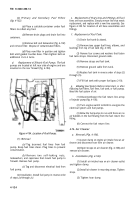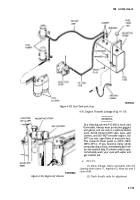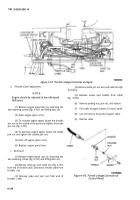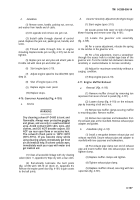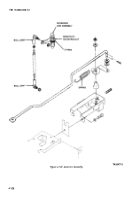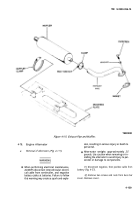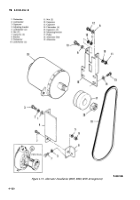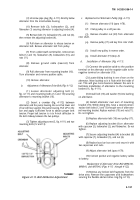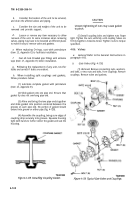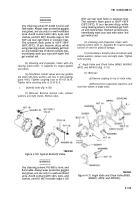TM-9-2330-356-14
SEMITRAILER, TANK: 5000 GALLON, BULK HAUL, SELF LOAD/UNLOAD M967 AND M967A1; SEMITRAILER, TANK: 5000 GALLON, FUEL DISPENSING, AUTOMOTIVE M969 AND M969A1; SEMITRAILER, TANK: 5000 GALLON, FUEL DISPENSING, UNDER/OVERWING AIRCRAFT M970 AND M970A1
TECHNICAL MANUAL; OPERATOR’S, UNIT, DIRECT SUPPORT, AND GENERAL SUPPORT MAINTENANCE MANUAL
OCTOBER 1990
TM-9-2330-356-14 - Page 270 of 528
TM 9-2330-356-14
4-79. Starter Motor
b. Removal (Fig. 4-124).
a.
Test, On Equipment (Fig. 4-123).
(1) Make sure batteries are fully charged and
that all battery and starter cables are serviceable and
properly installed.
(2) Turn engine switch (2, fig. 2-9) to RUN.
(3) Connect voltmeter as shown in figure 4-123,
Test A. Turn starter switch (4, fig. 4-9) to START. A
voltage reading (12V) indicates circuits leading to starter
are okay.
(4) Connect a voltmeter as shown in
figure 4-123, Test B. Turn starter switch (4, fig. 2-9) to
START.
(a)
If no voltage is indicated, solenoid is
defective. Replace solenoid (para 4-80).
(b)
If voltage is indicated, (12V) but starter
does not turn, starter is defective. Replace starter.
TA099853
Figure 4-123. Testing Engine Starter.
WARNING
When performing electrical maintenance,
ALWAYS disconnect intervehicular electrical
cable from semitrailer, and negative battery
cables at batteries. Failure to follow this
warning may create a spark and explosion,
resulting in serious injury or death to
personnel.
(1) Remove negative battery cable from battery
(fig. 4-37).
(2) Starter removal is done from underneath the
vehicle on the left side of the engine.
(3) Remove starter solenoid protective bracket
(1) by removing two retaining capscrews (2) and washers
(3). Remove five capscrews (4) from engine air shutter.
After these screws are removed, the engine air shutter can
be raised to get at top retaining bolt on starter.
(4) Remove hot lead No. 6 from large bottom
pole of solenoid and lead No. 74 from small pole on rear
side of solenoid.
(5) Remove capscrew (5), washer (6), capscrew
(7), external tooth lockwasher (8), and nut (9) from starter
rear support bracket (10). Remove rear starter bracket.
(6) Raise engine shutter (fig. 4-124) so you can
get at top retaining bolt on starter. Remove top capscrew
(11) and washer (12) using a 3/8-inch drive set, long
extension, universal joint, and a 9/16-inch universal
socket. Remove bottom capscrew (13) and washer (14),
then remove starter (15).
c.
Installation.
WARNING
When performing electrical maintenance,
ALWAYS disconnect intervehicular electrical
cable on semitrailer, and negative battery
cables at batteries. Failure to follow this
warning may create a spark and explosion,
resulting in serious injury or death to
personnel.
(1) Before installing starter motor, check the
pinion clearance (fig. 4-124). Proper clearance is
important to ensure that starter engages.
(a)
Press on solenoid core to shift the pinion
into full mesh position, then measure the clearance
between the pinion and pinion stop.
4-134
Back to Top

